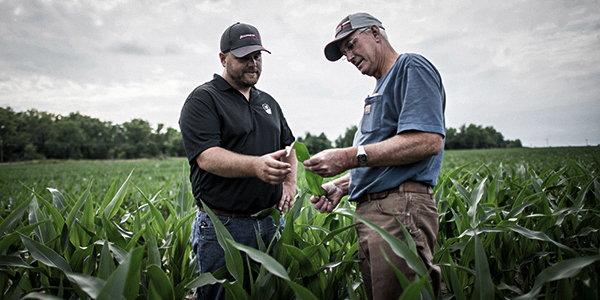AGRONOMICSUPPORT
YOU CAN TAKETO THE FIELD
What Defines High Quality Corn Silage?
One of the main factors affecting nutrient content is the amount of rainfall during key development stages and the impact that can have on the stalk-to-ear ratio. What nutrient specifications should be used to determine high or low quality, if a silage has an ideal fermentation profile and no mycotoxin issues?
Fiber digestibility has been a key that many discuss as a characteristic of quality corn silage. It is generally thought that silage higher in fiber digestibility will produce more milk. This is not necessarily accurate based on an extensive study that Penn State did in 2016/17. They took data from 24 farms and determined that the individual farms with the highest and lowest neutral-detergent fiber digestibility (NDFD) had similar breakeven cost. Fiber digestibility alone doesn’t determine how a cow will perform.
The level of starch and starch digestibility is also gaining interest in evaluating silage quality. The starch digestibility can increase with the time that it is stored. It usually peaks out around six months in storage, which is why many producers keep enough silage on hand to avoid feeding new crop for six months. It is possible to get around low starch and low starch digestibility by increased supplementation, but this will add cost to the ration.
The kernel processing score is not technically a quality measurement but is has been associated with higher milk production. In the same Penn State study, both the highest and lowest producing herds had excellent kernel processing scores, proving processing score alone doesn’t make a quality silage.
There is no one factor that defines corn silage quality. As a producer it is nearly impossible to hit every single quality standard for fiber, fiber digestibility, starch, starch digestibly, processing score, and particle size.
It is important to develop a plan to select corn hybrids that match your location, growing conditions and desired quality usage. Record keeping is key. Record planting date, hybrid, field, harvest date, fertility, where it is in the storage structure, quality characteristics at feed out, animal performance, and break evens. Advantage Acre® can help with this record keeping.
Here are some common forage quality terms and methods for determining energy content:
FORAGE QUALITY TERMS
Neutral-detergent fiber (NDF): Corn silage with a low NDF is desirable. It is a measurement of the total fiber content of a forage. NDF is composed of cellulose, hemicellulose, and lignin. Forages high in fiber will fill the stomach faster causing the animal to eat less and need more supplements to the ration. Corn silage NDF concentration can range from 36 to 50%.
Acid-detergent fiber (ADF). Corn silages with lower ADF values have a higher energy content and are desirable. ADF is a measurement of the cellulose, lignin, and pectin fiber fractions of forages. ADF is commonly used to predict energy content of corn silage and other forages. Corn silage ADF concentration can range from 18 to 26%.
Lignin. Corn silage with a low lignin content is desirable. Lignin is an indigestible fiber that has no energy value to the animal. Lignin also restricts digestibility of other fiber components. The lignin content of corn silage is low and ranges from about 2 to 4%.
In vitro dry matter digestibility (IVDMD). It is a measure of the apparent digestibility of dry matter. Determined by incubating feed in a flask with ruminal microbes and following this incubation with a pepsin and hydrochloric acid incubation to simulate digestion in the true stomach. The amount of dry matter remaining is divided by the original dry matter and subtracted from 1.0.
In vitro NDF digestibility (or cell wall digestibility). It is a measure of ruminal digestibility of NDF. Determined by incubating feed in a flask with ruminal microbes followed by analyzing the fiber content of the residue. The amount of fiber content remaining is divided by the original fiber content and subtracted from 1.0.
In situ dry matter digestibility. It is a measure of the apparent digestibility of dry matter. Determined by placing the forage sample in a dacron bag within the rumen of a cow or steer. The sample is retrieved, washed, dried, and weighed. The amount of dry matter remaining is divided by original dry matter and subtracted from 1.0.
In vivo digestibility. It is a measure of the digestibility of dry matter using animals. Disappearance of dry matter (digestibility) is determined as the difference between the quantity of dry matter consumed and the quantity of dry matter excreted in the feces.
Intake potential. High fiber diets fed to ruminants limit intake due to the filling effect of the food. Fiber (NDF) is fermented and passed from the rumen slowly compared to nonfibrous feed components such as sugars and starch. Less digestible fiber is retained in the rumen longer than highly digestible fiber. A low NDF content and high NDF digestibility of corn silage are desirable to maximize forage and dry matter intake. The NDF content of corn silage varies by hybrid and climate, and decreases with nitrogen fertilization and maturity at harvest. Corn silage with a low NDF content can be included in the ration at higher levels than corn silage with a high NDF content.
Protein. Crude protein is a mixture of true protein and nonprotein nitrogen. Less than 30% of the total protein in corn forage is available to the animal as absorbable true protein, as much of it is degraded by fermentation in the silo and in the rumen to nonprotein nitrogen. Much of the ammonia produced in the fermentation process is available to the animal. Bound protein, or heat-damaged protein, is crude protein that is unavailable to the animal. Crude protein levels of untreated corn silage range from less than 6% to over 10% of dry matter depending on environmental conditions, fertilization, hybrid, and maturity.
METHODS FOR DETERMINING ENERGY CONTENT
The energy content of corn silage is primarily determined by the amount and digestibility of fiber. Grain content also affects energy content. It is possible for a corn silage with less than 30% grain to have a higher energy content than a corn silage with more than 50% grain due to differences in stover digestibility. There are several techniques are used to estimate digestibility and energy content of corn silage.
Total digestible nutrients (TDN). Describes the energy content of feeds as the sum of the digestibilities of different nutrients. However, because animals use the available energy differently depending on the feed and on the animal's production status, the TDN system overestimates energy derived from forages relative to grain.
The net energy system. Accounts for the variation in digestible energy usage by assigning feeds three net energy values: net energy for maintenance (NEm), net energy for gain (NEg), and net energy for lactation (NEL). Digestible energy used for maintenance and for lactation (milk production) is used more efficiently than digestible energy used for gain.
The acid detergent fiber (ADF) content of silage is a common method used to predict energy content. The digestibility and the energy content increases as ADF decreases. ADF contains lignin (totally indigestible) as well as cellulose (poorly digestible) and pectin (highly digestible). The relationship between ADF and energy content is not absolute. The inaccuracy of this method is caused by significant variations in the digestibility of the fiber in corn silage.
In vitro digestibility methods use fermentation by ruminal microbes in test tubes or artificial rumens to determine digestibility. In situ digestibility methods allow forage digestion inside the rumen of a cow or steer. These methods offer greater accuracy of energy prediction because they account for variation in fiber digestibility but are more time consuming and expensive than ADF determination. Near-infrared reflectance (NIRS) equations accurately estimate in vitro values with less cost and time.
We hope this primer of silage and silage terminology sheds some light on the intricacies of corn silage.
Thank you for your support of LG Seeds and have a safe planting season!
Sources
- Defining Corn Silage Quality from Dairy Herd Management at www.dairyherd.com
- Influence of Ensiling on the Digestibility of Whole-Plant Corn Silage by L. Ferraretto, R. Shaver, and J. Lauer of the Department of Dairy Science, UW-Madison and Department of Agronomy, UW-Madison at www.fyi.extension.wisc.edu
- Quality and Feeding from Corn Agronomy at www.corn.agronomy.wisc.edu






Technical Team Agronomist